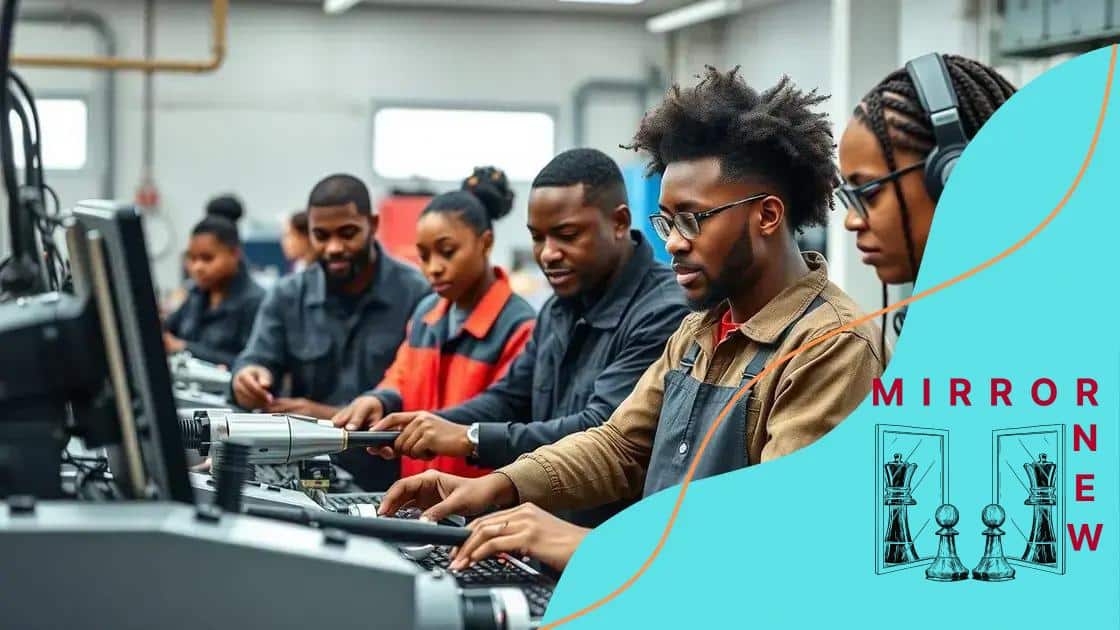Vocational education training for new technologies: a path to success

Vocational education training for new technologies equips students with practical skills and knowledge to meet industry demands, promoting job readiness and enhancing career opportunities in various fields.
Vocational education training for new technologies is reshaping the landscape of learning and career development. Are you ready to harness the power of new skills that meet the demands of modern industries? Let’s dive in!
Understanding vocational education and training
Understanding vocational education and training is essential in today’s fast-evolving job market. It provides individuals with the necessary skills to excel in various fields. This type of education focuses on practical, hands-on experiences that prepare students for real-world employment.
What is vocational education?
Vocational education encompasses programs that teach specific trades or skills. Unlike traditional education, which may focus on academic subjects, vocational training targets skills required for particular jobs. This approach benefits both students and employers by creating a workforce proficient in relevant, in-demand skills.
Benefits of vocational training
When considering options for education, one should recognize the advantages of vocational training. Here are some key benefits:
- Job readiness: Graduates often find employment quickly due to their practical experience.
- Industry connections: Many programs collaborate with local businesses, providing placement opportunities.
- Cost-effective: Vocational training can be more affordable compared to traditional college education.
- Flexibility: Many programs offer part-time or evening classes to accommodate working students.
Furthermore, vocational programs can adapt quickly to changes in technology and industry demands. For instance, training for new technologies is integrated into many curriculums. This ensures graduates are equipped with relevant skills that employers are seeking in today’s market.
Many students find vocational training appealing because it offers a clear path to careers. As people explore their options, understanding the differences between vocational training and traditional educational pathways can help make informed decisions.
Types of vocational education programs
There are various programs available, depending on the industry:
- Technical schools: Focused on fields like mechanics or electronics.
- Community colleges: Often offer a mix of vocational and academic programs.
- Apprenticeships: Combine on-the-job training with classroom instruction.
In addition to traditional educational paths, online vocational training has emerged as a popular avenue. This method allows individuals to learn at their own pace and fits the needs of those who prefer a flexible schedule. Overall, understanding vocational education and training opens doors to exciting career opportunities.
The importance of new technologies
The importance of new technologies in vocational education is undeniable. As industries evolve, staying current with new advancements is crucial. This ensures that students acquire skills that are in high demand in the job market.
The role of technology in learning
Integrating technology into vocational training enhances the learning experience. For example, students can engage in simulated environments that mimic real-world scenarios. This hands-on approach enables practical understanding and skill development.
New technologies shaping vocational education
Several emerging technologies have transformed how vocational training is delivered:
- Virtual Reality (VR): VR allows students to practice skills in a safe, controlled environment, from healthcare to manufacturing.
- Online Platforms: E-learning has made vocational courses accessible to many, breaking geographical barriers.
- 3D Printing: This technology provides a unique way to design and prototype for fields like engineering and design.
Moreover, the integration of Artificial Intelligence (AI) in courses is becoming more common. AI can personalize learning experiences, adapting to each student’s pace and style, which enhances understanding and retention of information.
As companies seek employees familiar with the latest tools and techniques, it is essential for vocational programs to keep pace. Students must not only learn practical skills but also understand the technologies that will support their success in the workforce.
Training programs are now implementing skills that focus on digital literacy, ensuring graduates are prepared for a tech-driven future. This focus on new technologies fosters a workforce that is versatile, knowledgeable, and ready to meet the challenges of modern jobs.
How vocational training adapts to industry needs

How vocational training adapts to industry needs is a crucial aspect of modern education. As industries evolve, vocational programs must adjust their curriculum to meet the changing demands of the workforce. This ensures that graduates are equipped with the skills necessary for success.
Identifying industry skills
Vocational training programs actively engage with industry leaders to understand which skills are in demand. By conducting surveys and interviews, educational institutions can align their training with real-world requirements. This proactive approach helps students gain valuable experience tailored to specific careers.
Incorporating feedback
Continuous feedback from employers plays a vital role in shaping vocational training programs. This includes:
- Curriculum updates: Programs are regularly revised based on the latest technology and methodologies used in the industry.
- Hands-on experience: Collaborations with businesses provide students with internships and practical training scenarios.
- Certification alignment: Ensuring that training programs meet recognized certification standards boosts employability.
Additionally, vocational training is increasingly integrating technology into its offerings. For instance, programs now include training on the latest software and equipment, reflecting advancements in fields like manufacturing and healthcare. This ensures that students are not only trained but are familiar with the tools they will use in their careers.
Another strategy for adaptation is the introduction of modular training. This allows students to learn specific skills relevant to their field without needing to commit to a full program. It also enables businesses to provide on-the-job training, further bridging the gap between education and employment.
By focusing on skill gaps and the needs of employers, vocational training plays a vital role in preparing a workforce that is skilled and competent. This adaptability is key to the continued success of vocational education.
Success stories from vocational training programs
Success stories from vocational training programs highlight the tangible benefits of practical education. Many individuals have transformed their lives through these programs, showcasing the real impact of vocational training.
Real-world examples
Consider the journey of a student who enrolled in a culinary arts program. After completing the training, they secured a position at a prestigious restaurant. Their hands-on experience played a crucial role in landing this opportunity, proving that vocational programs can lead directly to successful careers.
Industry-specific success
Vocational training is not limited to culinary arts. Many fields see remarkable success stories:
- Healthcare: Graduates of nursing assistant programs often find jobs quickly due to high demand.
- Information Technology: IT training programs help individuals land roles as technicians or developers, bridging skill gaps.
- Skilled trades: Electricians and plumbers from vocational schools report satisfying careers with good pay.
Additionally, some programs focus on underserved communities, providing essential skills to those who might not have access to traditional education. These trainees often find rewarding jobs that change their economic status and quality of life.
The partnership between vocational schools and local employers is vital in these success stories. Employers often provide internships and job placement assistance, ensuring that students transition smoothly into their careers. This collaboration strengthens the workforce and significantly benefits businesses seeking skilled workers.
Success stories are not just about high salaries or prestigious positions; they also show personal growth. Many graduates express how vocational training has given them confidence and a sense of purpose. This positive change is inspiring, proving that vocational education can change lives for the better.
Future trends in vocational education
Future trends in vocational education are reshaping how skills are taught and learned. As technology evolves and industries change, vocational training must adapt to meet new demands. This is crucial for preparing a skilled workforce that can thrive in the future.
Emphasis on technology integration
One significant trend is the increased use of technology in vocational programs. Many institutions are adopting online and blended learning models. This method allows students to learn at their own pace while still receiving hands-on experience in their chosen fields.
Industry partnerships
Another trend involves stronger collaborations between educational institutions and industries. These partnerships provide students with:
- Real-world experience: Internships and apprenticeships help students gain practical skills.
- Curriculum development: Employers can offer input on what skills are needed, helping to shape the training.
- Job placements: Strong ties to local businesses increase employment opportunities for graduates.
Additionally, there’s a growing focus on soft skills. Employers value not just technical skills but also abilities like communication, teamwork, and problem-solving. Vocational programs are responding by integrating these skills into their curriculums. This holistic approach ensures that students are well-rounded and ready for the workforce.
Another change is the shift towards modular training. This allows students to take short, focused courses on specific skills, rather than committing to long programs. This flexibility is appealing to those who may be working or have other commitments.
Finally, the rise of remote work is influencing vocational education. Many programs are now offering courses that prepare students for jobs that can be done from anywhere. This trend has opened up new opportunities and has changed the landscape of vocational training.
FAQ – Frequently Asked Questions about Vocational Education Training
What is vocational education training?
Vocational education training focuses on teaching specific skills for a particular job or career, combining practical experiences with theoretical knowledge.
How does vocational training adapt to industry needs?
Vocational training adapts by collaborating with industry leaders to ensure the curriculum meets current job demands and provides relevant skills.
What are the benefits of vocational education?
Vocational education offers job readiness, shorter training durations, hands-on experience, and often leads to higher employment rates.
Are there success stories from vocational training graduates?
Yes, many graduates report positive outcomes, including stable employment and career advancement, thanks to practical skills learned in vocational programs.





